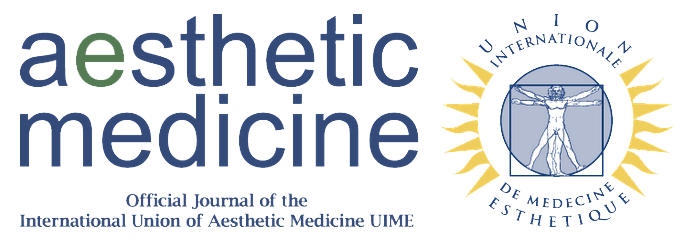Emergency management in the aesthetic medicine practice: a questionnaire to define the future of training in Italy
Keywords:
BLSD, training, resuscitationAbstract
Background: Out-of-hospital cardiac arrest is a critical condition with an average survival rate of around 10%, heavily influenced by the speed and competence of the intervention. Specific training for emergency management, such as BLSD (Basic Life Support and Defibrillation), is not mandatory for all physicians, including aesthetic doctors, who may encounter emergencies during outpatient treatments.
Aim: This study developed and validated a questionnaire to assess aesthetic doctors’ preparedness emergency management, the availability of emergency devices in clinics, the level of experience with handling emergencies, and opinions on specific training for aesthetic doctors.
Methods: A working group of aesthetic doctors developed the questionnaire after thoroughly reviewing the literature and current regulations. It was subsequently administered to a sample of 10 aesthetic doctors.
Results: The evaluation by the participants showed a high alignment with the study's objectives (average of 4.5 out of 5) and a high perceived usefulness for aesthetic medicine (average of 4.7 out of 5). The results indicate that 60% of the doctors had completed BLSD and ACLS/ALS (Advanced Cardiovascular Life Support/Advanced Life Support) courses, while 100% of the participants believe that BLSD should be mandatory. Additionally, 50% of the doctors had managed medical emergencies in the clinic, and 10% had dealt with a cardiac arrest.
Conclusions: Despite the small sample size, the results suggest the need for mandatory training to improve patient safety. Sharing the questionnaire with scientific societies in aesthetic medicine and encouraging more colleagues to complete it could contribute to the broader adoption of these training practices.
References
1. Stirparo G, Andreassi A, Sechi GM, Signorelli C. Spring, it’s time to ROSC. J Prev Med Hyg. 2023; 64(1):E87-E91.
2. Sanfilippo F, Corredor C, Santonocito C, et al. Amiodarone or lidocaine for cardiac arrest: a systematic review and meta-analysis. Resuscitation. 2016; 107:31-37.
3. Cournoyer A, Grunau B, Cheskes S, et al. Clinical outcomes following out-of-hospital cardiac arrest: the minute-by-minute impact of bystander cardiopulmonary resuscitation. Resuscitation. 2023; 185:109693.
4. Nehme Z, Andrew E, Bernard S, Smith K. Impact of cardiopulmonary resuscitation duration on survival from paramedic witnessed out-of-hospital cardiac arrests: an observational study. Resuscitation. 2016;100:25-31.
5. Bellini L, Fagoni N, Andreassi A, Sechi GM, Bonora R, Stirparo G. Effectiveness of cardiopulmonary resuscitation at the workplace. Med Lav. 2023; 114(3):e2023010.
6. Delhomme C, Njeim M, Varlet E et al. Automated external defibrillator use in out-of-hospital cardiac arrest: current limitations and solutions. Arch Cardiovasc Dis. 2019; 112(3):217-222.
7. Auricchio A, Gianquintieri L, Burkart R et al. Real-life time and distance covered by lay first responders alerted by means of smartphone-application: implications for early initiation of cardiopulmonary resuscitation and access to automatic external defibrillators. Resuscitation. 2019; 141:182-187.
8. Fagoni N, Bellini L, Bonora R, et al. Changing the stroke network during pandemic scenarios does not affect the management of patients with a positive Cincinnati prehospital stroke scale. Neurol Sci. 2024; 45(2):655-662.
9. Palmisano A, D'Angelo M, Gandolfini I et al. Borderline rejection: to treat or not to treat? Transpl Immunol. 2024; 84:102047.
10. Semeraro F, Scapigliati A, Tammaro G, Olcese U, Cerchiari EL, Ristagno G. Advanced life support provider course in Italy: a 5-year nationwide study to identify the determinants of course success. Resuscitation. 2015; 96:246-251.
11. Solla D, Magri Piccinini A, Gambolò L. Aesthetic medicine and basic life support: should it be a mandatory traning? Aesthetic Medicine. 2024; 10(3):e2024016.
12. Rohrich RJ, Parker TH, Broughton G, Garza R, LeBlanc D. The importance of advanced cardiac life support certification in office-based surgery. Plast Reconstr Surg. 2008; 121(3):93e-101e.
13. Goh CE, Mooney SJ, Siscovick DS, et al. Medical facilities in the neighborhood and incidence of sudden cardiac arrest. Resuscitation. 2018; 130:118-123.
14. Kudenchuk PJ, Stuart R, Husain S, Fahrenbruch C, Eisenberg M. Treatment and outcome of out-of-hospital cardiac arrest in outpatient health care facilities. Resuscitation. 2015; 97:97-102.
15. Oranges CM, Brucato D, Schaefer DJ, Kalbermatten DF, Harder Y. Complications of nonpermanent facial fillers: a systematic review. Plast Reconstr Surg Glob Open. 2021; 9(10):e3851.
Downloads
Published
Issue
Section
License
Copyright (c) 2025 Lorenzo Spadotto, Samuel Giaquinta, Pasquale Di Fronzo, Luca Gambolò

This work is licensed under a Creative Commons Attribution-NonCommercial 4.0 International License.
This is an Open Access article distributed under the terms of the Creative Commons Attribution License (https://creativecommons.org/licenses/by-nc/4.0) which permits unrestricted use, distribution, and reproduction in any medium, provided the original work is properly cited.
Transfer of Copyright and Permission to Reproduce Parts of Published Papers.
Authors retain the copyright for their published work. No formal permission will be required to reproduce parts (tables or illustrations) of published papers, provided the source is quoted appropriately and reproduction has no commercial intent. Reproductions with commercial intent will require written permission and payment of royalties.

This work is licensed under a Creative Commons Attribution-NonCommercial 4.0 International License.





